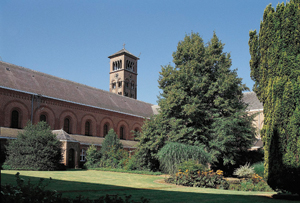by Jason Koehler of Devil Craft

To the east and a hair north of Antwerp proper in the municipality of Malle, situated among lush fields and grazing cattle lies a brewing tradition with few peers, but many imitators. Here, devout monks dedicated to a life of prayer, community, and work have been brewing beer in the classic abbey style since 1836. While visitors are not accepted to the monastery or brewery, their fine beers are available at a café across from the monastery, not to mention reputable cafés and restaurants in Belgium and the rest of the world, including Japan.
Trappist monks are members of the Cistercians of Strict Observance, taking their namesake from the La Trappe Abbey in Normandy, France. One of the ideologies of the Trappists is to live by the work of their hands. Fortunately for us, this means delicious beer.
The Trappist Abbey of Westmalle is the second largest of the Trappist abbeys which produce beer, second only to Chimay in size. Because the modern world isn’t compatible with their lifestyle, the monks are not currently active in the entire beer making process. In our world of e-mails, faxes, and power lunches, it would be impossible for them. Still, they strictly oversee the brewery operations, taking extreme care to ensure that the beer produced is of the absolute highest standard.
Westmalle, as well as other Trappist breweries, enjoys quite an enviable position from the perspective of cost and quality. They operate as charities with profits going to various causes; there is never a question of profitability and never any shortcutting of the final product. The monks limit the production of beer to a mere 160,000 hectoliters per year, refusing to increase production despite the ever increasing demand. Beers are given ample time to mature and undergo a second fermentation in the bottle in the brewery’s underground storage facility, which is between two and four weeks depending on the variety. Just above the spacious cellar, the abbey’s dairy cows graze in lush pastures.
French malt, local Malle water, and Czech and German hops are used with the signature Westmalle yeast to make their two main beers, Westmalle Dubbel at 7%, and Westmalle Tripel at 9.5%. Both use sugar, dark for the dubbel and light for the tripel, with higher concentrations in the latter. Hops are not weighed, but added by using the senses of the brewers– aroma and appearance being just as important as the weight. The spent grains are fed to the monastery cows, which produce milk for the cheese which is still made by the monks.
Westmalle was the first brewery to coin the term ‘tripel’ to refer to a strong beer with a light color and body. The tripel in its current form was created by Father Thomas, a brewing legend who was also a brewing scientist and who helped found the new brewery at the Trappist Monastery of Achel. He worked extensively to create their portfolio of beers. Now retired, he re-grew the abbey’s yeast from samples in the 1970’s, and the same strain is still in use today.
In Japan, Westmalle beers are imported by Konishi and are available at many specialty beer shops and Belgian-themed beer cafés.
Learn more at:
http://www.trappistwestmalle.be
http://www.konishi.be
This article was published in Japan Beer Times # () and is among the limited content available online. Order your copy through our online shop or download the digital version from the iTunes store to access the full contents of this issue.



